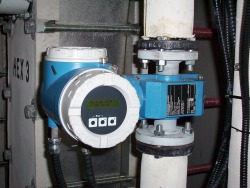District Energy

District energy (called district heating if no cooling energy is provided) is a system where heat or cooling is produced at a central location and distributed to nearby homes and buildings. District energy dates back to ancient Roman times and is very common in some parts of the world. In North America, district energy is used extensively on university and hospital campuses, but is less common in municipalities.
Revelstoke was one of the first municipalities in Canada to establish a district heating system based on renewable fuel. The system was opened in 2005, operated by the Revelstoke Community Energy Corporation. The system is fueled by wood waste from the Downie Timber mill, and provides steam to the mill as well as hot water to a dozen or so buildings in the downtown.
This brochure provides a background about the Revelstoke Community Energy Corporation, and a little bit more about the history of RCEC and district energy in the Revelstoke.
Compass Resource Management, one of the consultants on the Revelstoke CEEP project has prepared a detailed backgrounder about district energy, with specific information about the system used in Revelstoke. Check out the backgrounder report here.
In a nutshell, the RCEC system is a 1.5 MW biomass system with 1.75 MW of propane capacity for peaking/backup. Hot water is distributed to ten buildings via a 2 km network of insulated distribution piping. The energy centre also provides steam to Downie Timber for its kiln drying process. The energy plant was commissioned in 2005 and RCEC has been in operation since.
For more general information on district energy, see the handbook from the Canadian District Energy Association.
http://cdea.ca/resources/highlights-guidelines-and-manuals/UES%20Handbook%20Final%2021-01-08.pdf/view
Revelstoke was one of the first municipalities in Canada to establish a district heating system based on renewable fuel. The system was opened in 2005, operated by the Revelstoke Community Energy Corporation. The system is fueled by wood waste from the Downie Timber mill, and provides steam to the mill as well as hot water to a dozen or so buildings in the downtown.
This brochure provides a background about the Revelstoke Community Energy Corporation, and a little bit more about the history of RCEC and district energy in the Revelstoke.
Compass Resource Management, one of the consultants on the Revelstoke CEEP project has prepared a detailed backgrounder about district energy, with specific information about the system used in Revelstoke. Check out the backgrounder report here.
In a nutshell, the RCEC system is a 1.5 MW biomass system with 1.75 MW of propane capacity for peaking/backup. Hot water is distributed to ten buildings via a 2 km network of insulated distribution piping. The energy centre also provides steam to Downie Timber for its kiln drying process. The energy plant was commissioned in 2005 and RCEC has been in operation since.
For more general information on district energy, see the handbook from the Canadian District Energy Association.
http://cdea.ca/resources/highlights-guidelines-and-manuals/UES%20Handbook%20Final%2021-01-08.pdf/view
